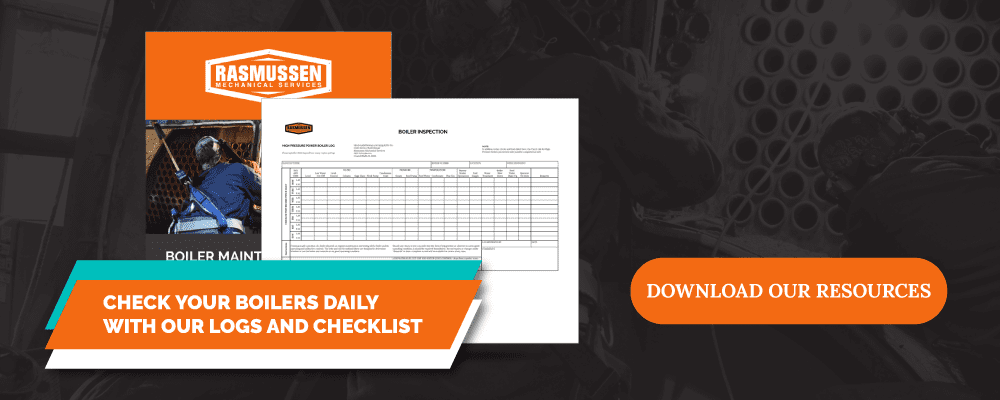When it comes to boilers, safety is not a joking matter. OSHA closely tracks the number of accidents resulting in injuries or fatalities on their website. As your single-source mechanical service provider, we are dedicated to keeping your employees safe!
Your safety is of utmost importance, but we also want to ensure that the time during your shutdown is efficient and that your equipment is not damaged. That is why we have gathered the steps to safely shut down a commercial boiler. Whether you are shutting down for a day, an annual inspection, or for the season, doing it wrong can be costly and dangerous.
Follow Your Manual
First and foremost, we always recommend always following your boiler manufacturer’s procedures for a shutdown. If your boiler did not come with a physical manual, you can often find your model’s care instructions on the manufacturer’s website.
Are you prepared for your next #boiler shutdown? @RasMech breaks it down to ensure a safe and effective shutdown: Click To TweetPreparation for Your Shutdown
To begin the process of shutting your boiler down, reduce the load and move the firing rate to the low position. Then, blow down your boiler AND boiler level controls and columns. Any sediment or sludge that has collected at the bottom of the boiler or the boiler bridles should be removed before cooling and draining the unit. By doing so, the sludge won’t harden or allow for corrosion. Not to mention, a blowdown is much easier than cleaning with a shovel and bucket after the commercial boiler is drained for the layup!
Next, consider a slow drain test of your level safety devices. You intend to shut down and drain the boiler anyway, so don’t waste the opportunity to ensure that your critical level safety devices will work when they are needed! The boiler should be supervised by a qualified operator during this process. This test closely simulates an actual boiler low water scenario by slowly dropping the water level until the low water safety cuts off fuel. The National Board of Boiler and Pressure Vessel Inspectors recommend a semi-annual slow drain test as part of their suggested boiler maintenance program.
[Ensure your boiler shutdown is going smoothly with our Boiler Maintenance Checklist and Logs.]
Once the burner has tripped and the commercial boiler has stopped producing steam, isolate the boiler with manual shutoff valves. For wet layup, you may wish to only isolate feedwater to prevent damage to the feedwater control valve. If your facility has multiple boilers on the same system and you will be opening the vessel for inspection, follow your Lock Out Tag Out procedures to isolate the boiler from all energy sources. At a minimum, plan to isolate and lock the following: main fuel, pilot fuel, feedwater, steam, continuous blowdown, surface blowdown, chemical feed, atomizing steam (if applicable), soot blower steam (if applicable), and electrical power to blowers, ignitors, and any other potentially hazardous energy source. Never trust a check valve to prevent backflow when your life is at stake. A double block and bleed arrangement or a blind flange in the system are preferred LOTO methods for life safety risks.
Fight the urge to cool the boiler quickly by opening the doors or running the combustion air blower. The best thing to do is to isolate the boiler and let it cool slowly on its own. This could take a couple of days, but slow cooling will prevent differential temperature stresses from damaging your boiler and the refractory inside it. “Pushing it” while cooling could be very costly! Be sure that at any given point, the reduction in temperature doesn’t exceed the manufacturer’s recommended rate. If your manual doesn’t note a rate, know that most manufacturers advise against a cooling rate faster than 100 degrees F per hour.
For steam boilers, after pressure has dropped to 10-25 PSIG (refer to your manual), open the boiler vent to prevent pulling a vacuum on the boiler.
Once the unit has dropped below 200 degrees, it’s ready to be drained (Dry layup) or filled completely (Wet Layup). Draining does not have to be immediate. However, it should be soon after cooling to prevent corrosion or freezing if shutting down in the winter.
There are benefits to wet and dry #boiler storage, so be sure to discuss what will be best for your facility before your next shutdown: Click To TweetOnce drained, be sure to do a thorough inspection of the boiler. Test, recertify or replace your safety valves in accordance with recommendations from your boiler insurance company. Invite your water treatment company to inspect for oxygen pitting, corrosion, or scale. Inside the boiler is the only place to know for certain that your water treatment program is working to protect your boiler as it should.
Before calling it a day, get your boiler ready to run for after the shutdown, outage, or summer, by replacing soft parts. Manway and handhole gaskets, sight glass packing, and other soft parts are not designed to run forever. Don’t let an inexpensive part cause a costly unplanned outage later. Replace these parts as part of your shutdown procedure so that if the boiler is needed quickly, this critical step isn’t missed.
Wet Storage vs. Dry Storage
If your commercial boiler will be shut down for over a week, decide if you will use wet storage or dry storage methods. There are benefits to each method, so be sure to discuss what will be best for your facility beforehand. Typically, your water treatment company can provide excellent guidance and the chemicals needed to layup your boiler without damage in either scenario.
Wet storage is typically used for short durations. It includes filling the unit completely (no air) with chemically treated water. This water should be consistently checked for a buffer of oxygen scavenger. If all valves are closed completely with an airtight seal, this will help minimize any issues in regards to oxygen. When done right, there are two big perks of wet storage: Wet storage keeps your boiler from rust or corrosion, and it allows a quicker startup when your facility is next in need of the boiler as filling time is eliminated. Further, a wet layup prevents the waste of hundreds or thousands of gallons of water. Drawbacks to wet layup include the maintenance of chemicals, the risk of oxygen corrosion, and the risk of freezing. Use caution when considering wet layup for a boiler that is partially or completely outdoors in winter months. Take care to prevent the freezing of economizers and other equipment during cold weather. Consult your water treatment company for recommendations on chemicals and dosage.
Dry storage is typically used for long-duration shutdowns or inspections. It’s when all water is drained from the unit and is dried. The unit must be dried completely, or your boiler may be susceptible to corrosion in the puddles. As with wet storage, it’s also important to seal the unit from the outside environment. Typically the gaskets are replaced and the boiler is closed with nitrogen, desiccant or VPCI (Vapor Phase Corrosion Inhibitor) inside to prevent moisture and oxygen from ambient air corroding the boiler internals. Desiccant may have to be removed before filling the boiler for operations, while some VPCI products are water-soluble, allowing a plant to fill and run, without opening the boiler to remove preservatives. Consult your water treatment company for recommendations.
For more information, talk to your water treatment company and boiler insurance company, check out ASME Section VII, or contact a professional at Rasmussen Mechanical Services.
Whether you’re looking to fix a leak or perform your annual boiler tune-up, the boiler experts are Rasmussen Mechanical Services is happy to assist you in your preparation, shut down, maintenance, and startup. Let the experts help you in prolonging the life of your commercial boiler, and in turn, save your facility money. Reach out to our staff of technicians to see how we can assist you in all of your maintenance needs.




